On October 25th, Odaily, DFG and Acala jointly held the "All Things Grow - Polkadot Ecological Theme Meeting" in Shanghai. Representatives of professional investment institutions, project parties who will participate in the front-line bidding, development teams, foundation community leaders and other ecological roles stand together at a new starting point when Polkadot officially enters the application stage, predict the development trend of the ecology, and explore various Prospects for class applications.

On October 25th, Odaily, DFG and Acala jointly held the "All Things Grow - Polkadot Ecological Theme Meeting" in Shanghai. Representatives of professional investment institutions, project parties who will participate in the front-line bidding, development teams, foundation community leaders and other ecological roles stand together at a new starting point when Polkadot officially enters the application stage, predict the development trend of the ecology, and explore various Prospects for class applications.
Meanwhile, Acala open contributor Yu Zhu introduced Polkadot's upcoming parachain slot auction and some of Acala's auction plans in his keynote speech on "Polkadot, Acala and Parachain Slot Auction". Yu Zhu said that there are four ways to participate in Acala's auction crowdloan: the first is to participate directly on the chain, and the threshold requirement is at least 5 DOT; the second is to participate through lcDOT's liquidity plan, the threshold is Not only is there only one DOT, but lcDOT can also be used to release the liquidity of its own chips. After the lease period is over, lcDOT can freely redeem DOTs; the third and fourth methods are through some centralized exchanges that support Polkadot auctions Anywhere or mobile wallet to participate.
The following is the full text of Yu Zhu's speech, edited by Odaily, enjoy~
Thank you for coming to today's event. This may be the first Polkadot-themed open event of this year's Bund Blockchain Week. My name is Yu Zhu, and I come from Acala. Today I will bring you Polkadot, Acala, and Crowdloan. Come and share.
Let's talk about Polkadot first. Turning the time back to 2017 when Polkadot first came out, many people here may have learned about Polkadot because of Gavin Wood. He used to be the CTO of Ethereum and the author of the Ethereum Yellow Paper. In fact, in addition to Gavin, Polkadot has two other co-founders, Robert Habermeier and Peter Czaban. They and all other ecological contributors have worked hard to prove that Polkadot's path forward is correct. Today, those who once boasted are basically realized one by one.

So, what is Polkadot? To put it simply, it has two functions, one is to provide operability for the blockchain, and the other is to provide security for the blockchain.
Polkadot is divided into relay chain and parachain in architecture. The relay chain is relatively easy to understand. The relay chain is responsible for the verification of information interaction and maintains the security of the entire network. The relay chain is responsible for the verification of information interaction and maintaining the security of the entire network; the parachain is responsible for handling various "trivial matters", and different parachains can focus on different needs.

As far as the currently active projects in the ecosystem are concerned, parachains can be smart contract platforms, DeFi protocols, or privacy solutions. In a broad sense, parachains actually belong to Layer1, but unlike other Layer1 public chains, parachains need to share security with the relay chain.
For projects in the ecology, there are many reasons to choose Polkadot-based construction. The first is cross-chain interoperability, the second is scalability, the third is shareable security, the fourth is the convenience of the Substrate development framework, the fifth is complete on-chain governance, and the sixth is no fork upgrade.
Let me share some data as of the time of making the PPT. The market value of Polkadot has reached 42 billion U.S. dollars, and Kusama, the first network, also has 400 million U.S. dollars. At present, more than 200 teams have been deeply involved in the Polkadot/Kusama ecosystem, the number of verification nodes has exceeded 1,200, and 11 parallel chains on the Kusama network have also been launched.
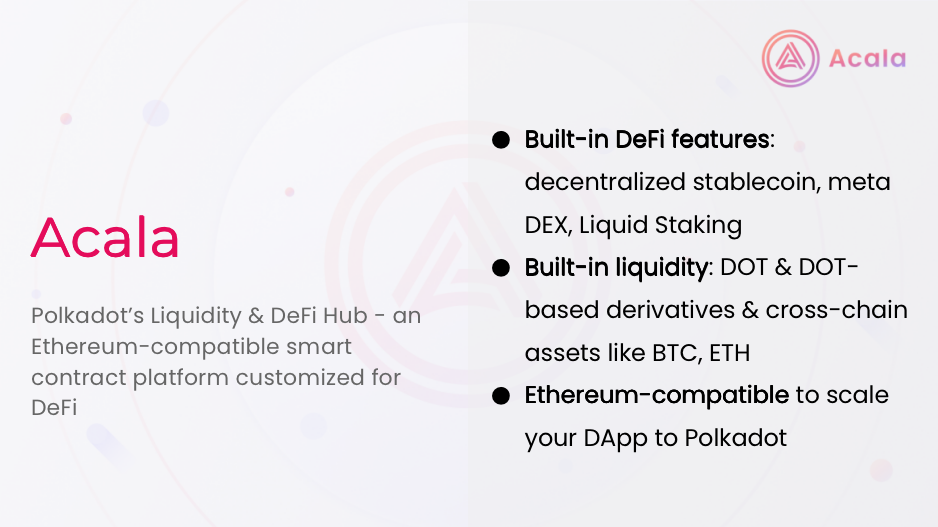
Next, let’s talk about Acala, which is positioned as Polkadot’s DeFi center. Of course, our service direction in the future is not limited to DeFi users. Acala has previously announced that it has reached a cooperation with the financial giant Current to serve traditional financial customers by cooperating with institutions like them.
As Polkadot's DeFi center, Acala has brought a series of DeFi infrastructure to Polkadot, such as decentralized stablecoins, DEX, and liquid release solutions (LDOT). Acala will provide financial liquidity services for various assets in the Polkadot ecosystem, including DOT and some derivative assets, and assets from cross-chain bridges.
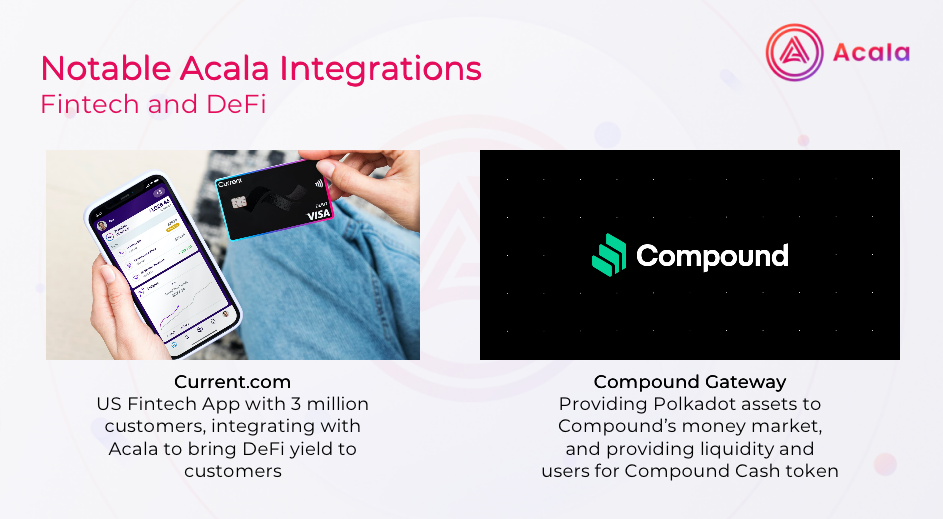
In addition, another key product of Acala is our EVM+. Acala is a smart contract parachain with good EVM compatibility. Applications developed based on Ethereum and similar underlying layers can be quickly transplanted to Acala's parachain, and then enter the Polkadot ecosystem without the need for a bridge.
Up to now, Acala has two very important cooperations, one is the Current we just mentioned, and the other is the cooperation with Compound Chain. After we go online, the assets on Acala can be quickly integrated into the Compound Chain for loans and enjoy some benefits. Of course, the assets on the Compound Chain can also come to us.
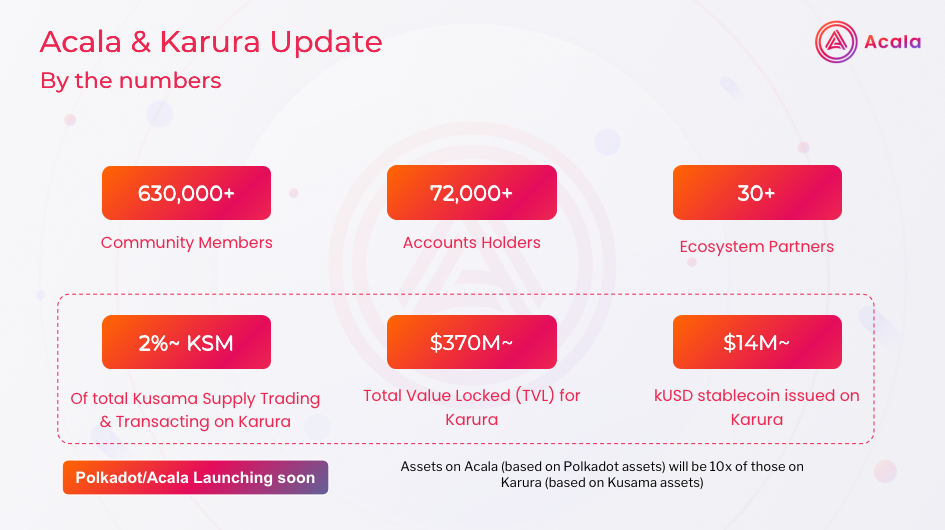
Security has been our top priority since Acala's inception. In Acala's view, the security of DeFi projects is divided into two levels. One is the security at the code level. In this regard, Acala has commissioned multiple third-party security agencies such as SRLabs, Trail of Bits, and SlowMist to conduct multiple rounds of code audits. The second is the security at the economic model level. In this regard, Acala also entrusted Gauntlet, an on-chain risk management simulation platform that has done economic model audits for many well-known DeFi projects such as Aave and Sushiswap, to provide Acala with automated financial risk management.
Next, share some of Acala's performance at the data level. We now have hundreds of thousands of community users and more than 30 ecological partners around the world. On the Karura network that has been connected to the Kusama parachain, there are now 72,000 addresses, and 2% of KSM is placed on the Karura network. The total value of the network lockup has now reached 370 million US dollars.
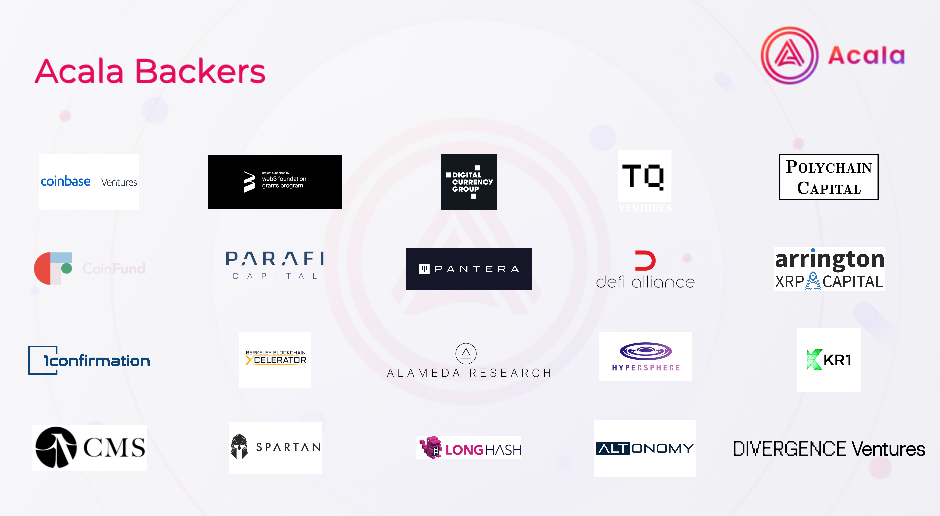
Regarding Acala, many people have a question, is Acala a so-called "domestic project"? In fact, Acala's team members are located all over the world, most of them in New Zealand, the United States and Europe. Judging from past performance, I can say unceremoniously that we are the most powerful development team in the Polkadot ecosystem.
This is the list of our investment institutions. I won’t go into details one by one. Just look at the picture.
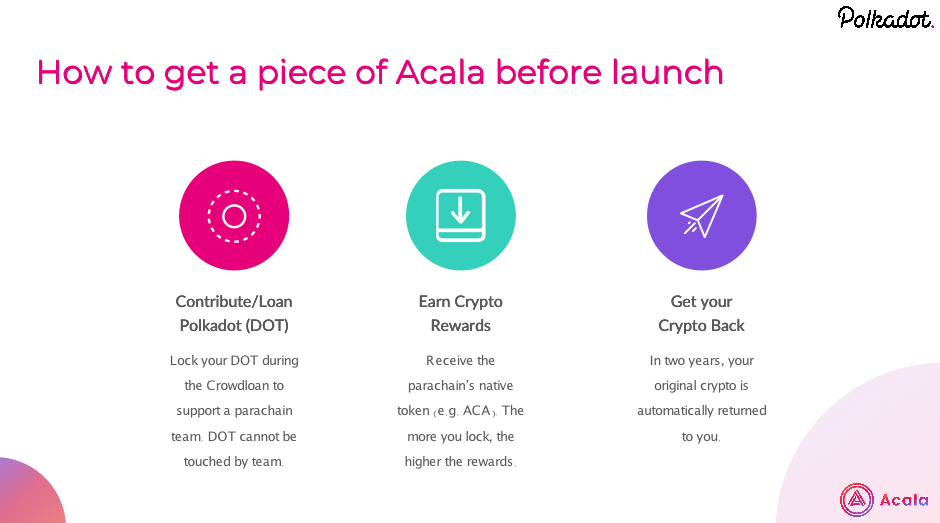
Next I'll talk about starting Acala. Let me first talk about why we need parachain slots, because we need to get plug-and-play blockchain security and interoperability, which can only be achieved by taking down slots and becoming parachains.
Regarding the parachain auction, Polkadot has designed a mechanism for all DOT/KSM holders to participate in the crowd loan (Crowdloan). Users can help the auction by voting their DOT/KSM to the designated project party, and the project party will It is necessary to distribute certain incentives to attract more users to vote for themselves. Once the auction is completed, the DOT/KSM cast will be locked immediately and can only be redeemed after the slot lease period ends. Crowdloan is actually a loan relationship. Users need to invest DOT/KSM to the project party during the entire lease period. The incentive given by the project party is interest.
Why use Crowdloan to obtain the platform? Because in the field of blockchain, it is very important for the community to be a force, and we also hope to gain some support from the community through Crowdloan to exert collective power. Another point is that Crowdloan is also a process of survival of the fittest. The number of Polkadot parachain slots is limited. Project parties need to compete with each other, and users will support the highest quality projects out of the need to maximize profits.
Another very important point is that the voted project party will never touch the DOT/KSM voted to itself through Crowdloans, and the tokens will be locked on the chain.
According to the current plan, there is a high probability that Polkadot will start the first round of parachain slot auctions on the mainnet on November 11. We will definitely participate in the first round. If we don’t win, we will continue to shoot until we win. Crowdloans will actually open shortly before the auction officially starts, which means that everyone can participate before November 11. Regarding the lease period, our plan is to shoot for two years. After the two years are over, everyone can take back their DOTs. Of course, we will definitely bid to renew the lease after two years.
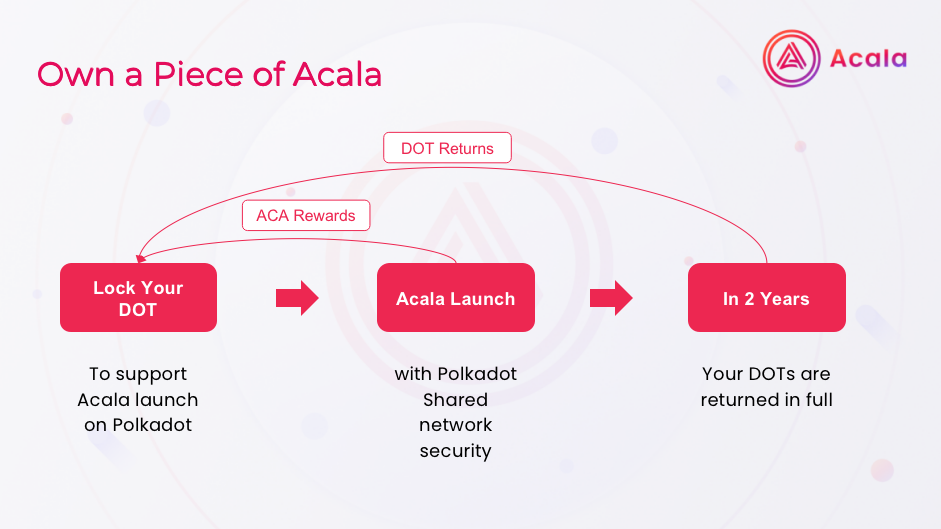
Users who have participated in the Kusama parachain auction should know that its lease period is one year, which may be acceptable to many users, but the Polkadot mainnet auction is two years, which may be too long. In response to this problem, we have also developed a liquidity solution product lcDOT. For example, when Acala starts the auction, users can get 100 IcDOTs by investing 100 DOTs through this scheme. After the two-year lease period ends, IcDOTs can be redeemed for DOTs 1:1, but during this period, lcDOTs It is free liquidity, so that the locked token liquidity can be released.
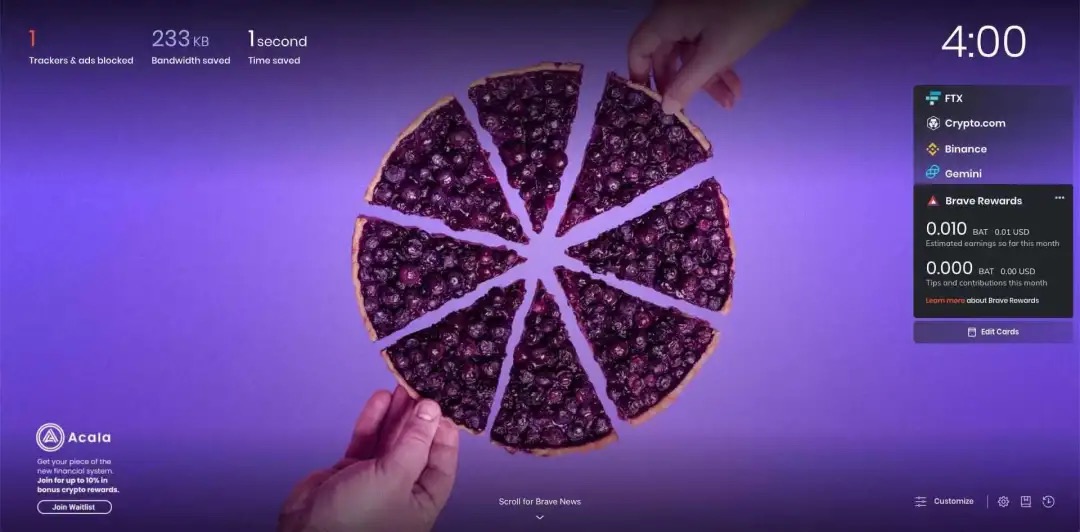
There are four ways to participate in Acala’s Crowdloan auction: the first is to participate directly on the chain, and the threshold requirement is at least 5 DOT; the second is to participate through lcDOT’s liquidity plan, and the threshold is not only 1 DOT can also release the liquidity of its own chips through lcDOT. After the lease period is over, lcDOT can freely redeem DOT; the third and fourth methods are through some centralized exchanges or mobile wallets that support Polkadot auctions come and participate.
The last thing I want to say is that we made an opening page advertisement in the Brave browser in September, which attracted many non-Polkadot ecological users during the announcement process. For these users who are not in the Polkadot ecosystem, the prerequisite for participating in auctions and other on-chain activities is to have a Polkadot wallet and a certain amount of DOT as a handling fee. In order to facilitate users to quickly familiarize themselves with the Polkadot ecology, we have launched a game. Users who complete this game can get an extra 2% Bonus. people get involved. If you are interested, you can log on to our official website (https://acala.network/acala/quests#quests).